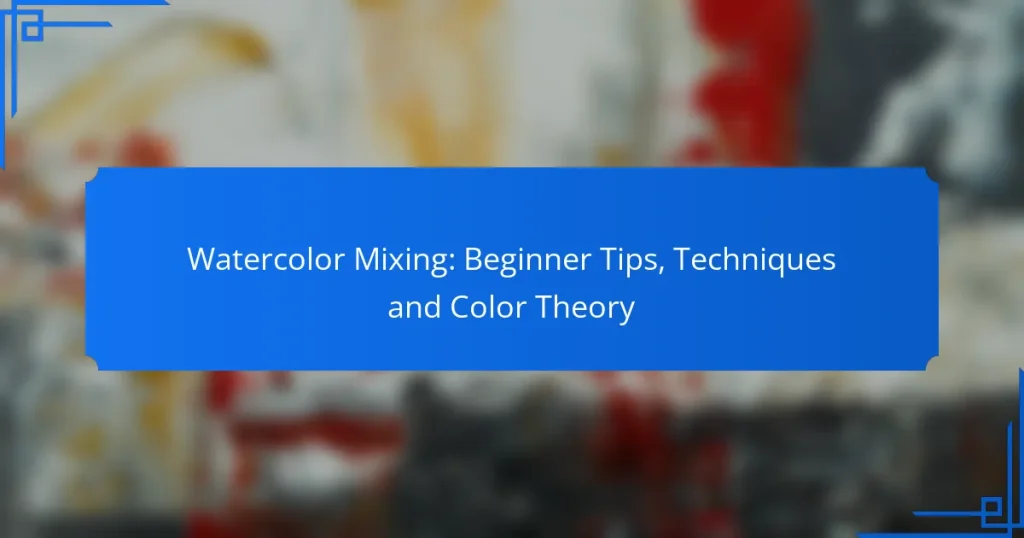Color mixing is a fundamental skill in art that allows you to create a wide range of hues and effects. By mastering techniques such as subtractive and additive mixing, as well as utilizing tools like palettes and brushes, you can significantly enhance your artwork. Understanding the relationships between colors is key to achieving your desired outcomes and bringing your creative vision to life.
CMYK Color Mixing: Print Design Fundamentals, Color Models and Techniques
Creating Skin Tones: Techniques, Color Theory and Application for Portrait Artists
Watercolor Mixing: Beginner Tips, Techniques and Color Theory
RGB Color Mixing: Digital Art Techniques, Color Models and Applications
Acrylic Paint Mixing: Techniques, Home Decor Applications and Color Theory
Color Mixing in Photography: Science, Techniques and Effects
What Are the Best Color Mixing Techniques?
The best color mixing techniques depend on the medium and desired outcome. Understanding subtractive and additive mixing, as well as practical applications like layering and glazing, can enhance your color work significantly.
Subtractive color mixing
Subtractive color mixing occurs when pigments or dyes are combined, absorbing certain wavelengths of light and reflecting others. This method is commonly used in painting and printing, where colors are created by layering pigments. For example, mixing cyan, magenta, and yellow (the primary colors in subtractive mixing) can produce a wide range of hues.
When using subtractive mixing, consider the transparency and opacity of your pigments. Transparent colors can create more vibrant results when layered, while opaque colors may dull the mixture. Always test combinations on a small scale before applying them to larger projects.
Additive color mixing
Additive color mixing involves combining light colors, where the primary colors are red, green, and blue. This technique is fundamental in digital media and stage lighting, where colors are created by mixing different light sources. For instance, combining red and green light produces yellow.
In additive mixing, the more colors you combine, the lighter the result becomes. Be mindful of the intensity and brightness of each light source, as they can significantly affect the final color. This method is particularly effective for screens and LED displays.
Color wheel application
The color wheel is a visual representation of colors arranged according to their chromatic relationship. It helps in understanding color harmony and mixing techniques. By using complementary, analogous, or triadic color schemes, artists can create visually appealing compositions.
When applying the color wheel, consider the emotional impact of color combinations. For example, complementary colors can create contrast and vibrancy, while analogous colors provide harmony. Experiment with different schemes to find the best fit for your artistic vision.
Layering techniques
Layering techniques involve applying multiple layers of color to achieve depth and richness in your artwork. This method is particularly effective in painting, where each layer can build upon the previous one, creating complex textures and tones. Use thin layers for transparency or thicker applications for opacity.
To master layering, start with a base color and gradually add layers, allowing each to dry before applying the next. This approach helps prevent muddy colors and allows for adjustments. Keep in mind that the order of colors can affect the final outcome, so plan your layers strategically.
Glazing methods
Glazing is a technique where a transparent layer of color is applied over a dried layer, allowing the underlying color to show through. This method can enhance luminosity and depth in your artwork, making colors appear more vibrant. It is commonly used in oil painting but can also be applied in acrylics.
When glazing, use a medium to dilute your paint, ensuring it remains transparent. Apply thin layers and build up gradually to achieve the desired effect. Be cautious with the choice of colors, as some combinations can lead to unexpected results. Always test your glazes on a separate surface before applying them to your main work.
How to Mix Colors for Painting?
Mixing colors for painting involves combining different pigments to create new hues. Understanding the relationships between colors is essential for achieving the desired results in your artwork.
Using primary colors
Primary colors are the foundation of color mixing and include red, blue, and yellow. These colors cannot be created by mixing other colors together, making them essential for any artist’s palette.
When mixing primary colors, remember that the ratios will affect the resulting shade. For example, mixing equal parts of blue and yellow will yield a vibrant green, while adding more yellow will create a lighter shade.
Creating secondary colors
Secondary colors are formed by mixing two primary colors. The three secondary colors are green (blue + yellow), orange (red + yellow), and purple (red + blue).
To achieve secondary colors, blend equal amounts of the two primary colors. Adjusting the proportions can create a range of shades; for instance, more red in the orange mix will produce a deeper hue.
Achieving tertiary colors
Tertiary colors result from mixing a primary color with a secondary color. Examples include red-orange, yellow-green, and blue-purple. These colors add depth and variety to your palette.
To create tertiary colors, start with a primary color and gradually mix in a secondary color. This approach allows for fine-tuning the hue, enabling you to achieve the exact shade you desire for your painting.
What Tools Are Needed for Color Mixing?
To effectively mix colors, you need a few essential tools that enhance your ability to create the desired hues. The primary tools include a palette, mixing mediums, and appropriate brushes, each playing a crucial role in the mixing process.
Palette types
Choosing the right palette is vital for successful color mixing. Common types include wooden, plastic, and glass palettes, each offering different surfaces and ease of cleaning. A disposable palette pad can also be useful for quick projects or beginners.
Wooden palettes provide a traditional feel and are often favored by oil painters, while plastic palettes are lightweight and easy to clean, making them ideal for acrylics. Glass palettes offer a smooth surface that allows for easy mixing and visibility of colors.
Mixing mediums
Mixing mediums are substances added to paint to alter its properties, such as texture, drying time, and finish. For example, acrylic mediums can increase transparency or extend drying time, while oil mediums can enhance gloss and flow.
When selecting a medium, consider the type of paint you are using and the desired effect. Always follow the manufacturer’s guidelines for mixing ratios to achieve the best results without compromising the paint’s integrity.
Brush selection
The choice of brush can significantly impact your color mixing experience. Different brushes, such as flat, round, or filbert, offer various mixing capabilities and textures. A flat brush is excellent for blending large areas, while a round brush is better for detailed work.
When mixing colors, opt for brushes with stiff bristles to ensure thorough blending. Avoid using worn-out brushes, as they can lead to uneven mixing and undesirable textures in your paint application.
What Are Common Mistakes in Color Mixing?
Common mistakes in color mixing can lead to unsatisfactory results, such as muddy colors or unbalanced palettes. Understanding these pitfalls can help artists and designers achieve more vibrant and harmonious mixes.
Overmixing colors
Overmixing colors often results in a dull or muddy appearance. When colors are blended too thoroughly, the vibrancy can diminish, and the unique characteristics of each hue may be lost. Aim for a balance; sometimes, leaving slight variations can enhance the overall effect.
A practical tip is to mix colors in small increments, checking the result frequently. This approach allows for better control over the final shade and helps prevent the loss of vibrancy.
Ignoring color theory
Ignoring color theory can lead to unintentional clashes or imbalances in your palette. Understanding concepts like complementary colors, analogous colors, and color harmony is essential for creating visually appealing compositions. Familiarize yourself with the color wheel to make informed choices.
For example, using complementary colors can create striking contrasts, while analogous colors can provide a more harmonious look. Always consider the emotional impact of colors as well, as they can evoke different feelings and responses.
Not testing mixtures
Not testing mixtures before applying them can result in unexpected outcomes. Always experiment with small amounts of paint or pigment on a separate surface to see how colors interact. This practice can save time and resources by preventing larger mistakes.
A simple method is to create a swatch chart with your mixtures. This allows you to visualize the results and make adjustments before committing to a larger project. Remember, testing can be the key to achieving the desired effect in your work.
How to Choose the Right Color Mixing Technique?
Choosing the right color mixing technique depends on your project goals, the medium you are using, and the desired outcome. Understanding these factors will help you select the most effective method for achieving your artistic vision.
Assessing project requirements
Begin by identifying the specific requirements of your project. Consider the overall theme, the emotional response you wish to evoke, and the context in which the colors will be used. For instance, a vibrant, energetic piece may benefit from a different mixing technique than a subdued, calming artwork.
Next, evaluate the scale and complexity of your project. Larger projects might require more efficient mixing methods, while smaller, detailed works can afford more intricate techniques. Always align your choice with the intended audience and the setting where the artwork will be displayed.
Considering medium type
The medium you choose significantly influences your color mixing technique. For example, oil paints allow for smooth blending and layering, making techniques like glazing effective. In contrast, acrylics dry quickly, so techniques such as wet-on-wet or dry brushing may be more suitable.
Watercolors require a different approach, often focusing on transparency and layering. Techniques like wet-on-dry or wet-on-wet can create various effects. Always test your chosen method on a small scale to see how it interacts with your specific medium before committing to the entire piece.






